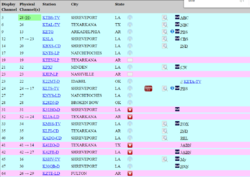Wireless mic drop out
- Thread starter prodjay
- Start date
You are using an out of date browser. It may not display this or other websites correctly.
You should upgrade or use an alternative browser.
You should upgrade or use an alternative browser.
Interference is the number one culprit. Do you know what band you are in and what else is in that band at that location?
The UHF 600 MHz band is in the process of going away (not available in half the US now). Those TV stations are being repacked into the 500 MHz band. This means fewer open frequencies for wireless. If you haven't set your frequencies in a while, this could be your problem. If you are using 2.4 Ghz mics, you could have WiFi interference or you may have held the mic with your hand over the antenna.
The UHF 600 MHz band is in the process of going away (not available in half the US now). Those TV stations are being repacked into the 500 MHz band. This means fewer open frequencies for wireless. If you haven't set your frequencies in a while, this could be your problem. If you are using 2.4 Ghz mics, you could have WiFi interference or you may have held the mic with your hand over the antenna.
I used two different 600 MHz and one 500 MHz wireless mics, all had the same results.
All would start to drop out after about 50 ft from the base units. All had nothing between the base and the handheld.
I tried my EV RE2, my Shure SLX, and My GTD.
Most of the time I can go WAAAAY longer than 50 ft.
All would start to drop out after about 50 ft from the base units. All had nothing between the base and the handheld.
I tried my EV RE2, my Shure SLX, and My GTD.
Most of the time I can go WAAAAY longer than 50 ft.
I used two different 600 MHz and one 500 MHz wireless mics, all had the same results.
All would start to drop out after about 50 ft from the base units. All had nothing between the base and the handheld.
I tried my EV RE2, my Shure SLX, and My GTD.
Most of the time I can go WAAAAY longer than 50 ft.
I think you just answered your own question. If you tried multiple mics in that area and they all were dropping out then obviously that metal structure (or something in that area) is the culprit.
Doubtful that it's the canopy. More likely it's just a crowded frequency band and possibly poor antenna placement.
ProDJay Shreveport and its environs were hit in the first 3 phases of the 600 MHz repack with more change due in the middle of next year. Each phase has more TV stations changing channels. Here is what your area looks like channel wise (from RabbitEars.com). This doesn't show what channels emergency services are using in your area though. Those are usually below 512 MHz (channels 20 and below). It looks like channel 21 (512-518 MHz) and 25 (536-542 MHz) should be clear (regardless of repack or nearby location.


time to upgrade to better units. SLX can use the same band as the 500ish G50 from QLXD but nowhere near as robust, not even close really. I have had them at the same gig, and I could never "lockdown" on SLX like I can on the QLXD.
If you don't want to spend the cash, invest in a better antenna that you can raise up when you have a problem, but that is the cost of a QLXD unit, lol.
Two Shure paddle antennas are not cheap, and if you are still having continuous issues, you know it's time for abetter unit, and you could use the paddles on the new units.
If you don't want to spend the cash, invest in a better antenna that you can raise up when you have a problem, but that is the cost of a QLXD unit, lol.
Two Shure paddle antennas are not cheap, and if you are still having continuous issues, you know it's time for abetter unit, and you could use the paddles on the new units.
I used two different 600 MHz and one 500 MHz wireless mics, all had the same results.
All would start to drop out after about 50 ft from the base units. All had nothing between the base and the handheld.
I tried my EV RE2, my Shure SLX, and My GTD.
Most of the time I can go WAAAAY longer than 50 ft.
You tried multiple frequencies on each?
You tried multiple frequencies on each?
Yes, all with the same result.
The only 600MHz frequencies I use now are 614-616 and 657-663 (both are buffer bands usable with unlicensed systems). Occasionally I have used 655 but that's for licensed systems (and you can't get a "license" with less than 50 units in use), but I'm in a rural area, so not a whole lot of competition for use.
The guard band (614-616) and duplex gap (657-653) where you are operating should be pretty safe areas but time will tell. At issue is the spectral leakage for the uplink and downlink bands. T-Mobile is mostly occupying the center of those bands. Hopefully whoever is occupying the edges uses good filtering.The only 600MHz frequencies I use now are 614-616 and 657-663 (both are buffer bands usable with unlicensed systems). Occasionally I have used 655 but that's for licensed systems (and you can't get a "license" with less than 50 units in use), but I'm in a rural area, so not a whole lot of competition for use.
BTW, to be in full compliance, the wireless systems used in the guard band and duplex gap cannot be tunable into the uplink or downlink bands. Also, the power is limited to 20mW if memory serves me correctly. Older mics may be operating at 30 or 50 mW.
Mine cover most of the 600 band, so I feel like a rebel ...BTW, to be in full compliance, the wireless systems used in the guard band and duplex gap cannot be tunable into the uplink or downlink bands. Also, the power is limited to 20mW if memory serves me correctly. Older mics may be operating at 30 or 50 mW.
I have one in whole 600 band tooMine cover most of the 600 band, so I feel like a rebel ...
600Mhz is set aside for broadband. When a wireless mic encounters that kind of interference the broadband always wins.
Last edited:



